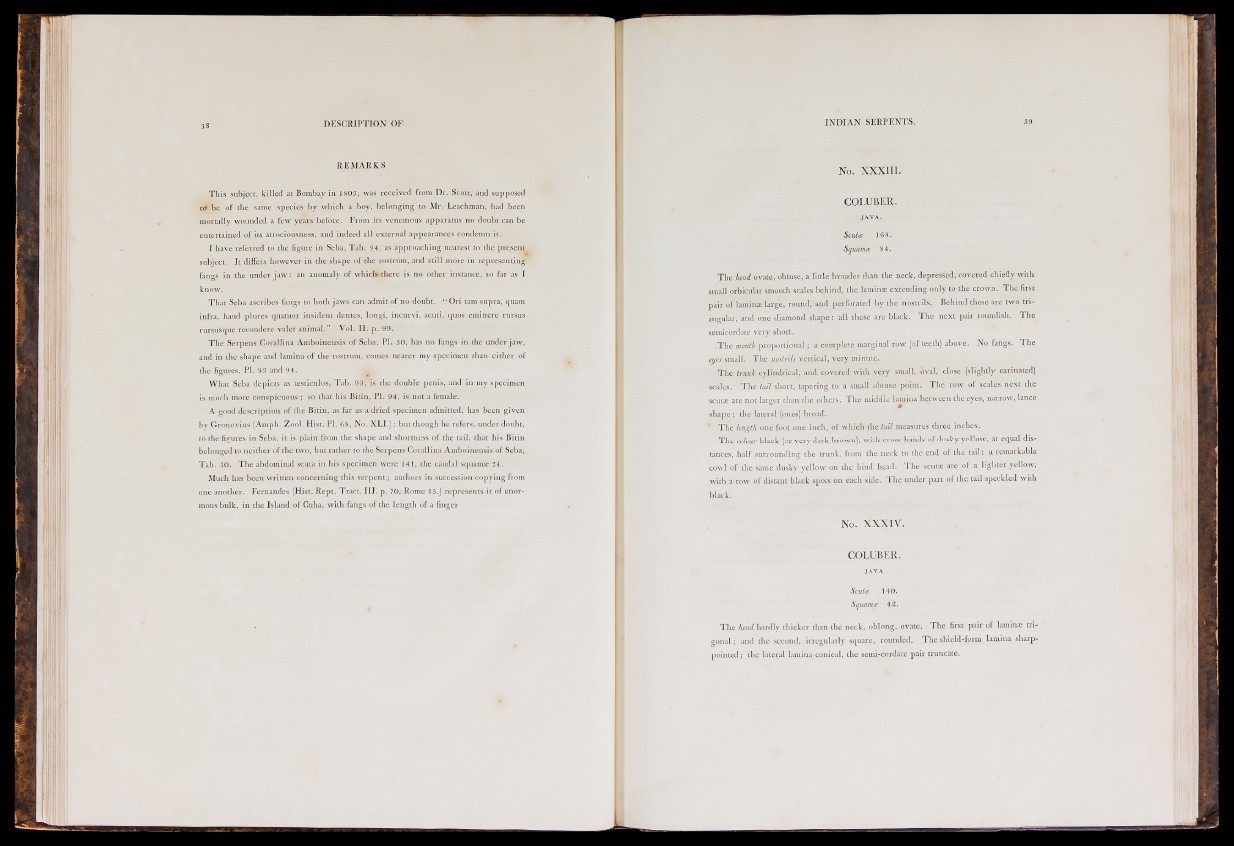
DESCRIPTION OF
R E M A R K S
This subject, killed at Bombay in 1S03, was received from Dr. Scott, and supposed
t(T be of the same species by which a boy, belonging to Mr. Leachman, had been
mortally wounded a few years before. From its venemous apparatus no doubt can be
entertained of its atrociousness, and indeed all external appearances condemn it.
I have referred to the figure in Seba, Tab. 94, as approaching nearest to the present
subject. It differs however in the shape of the rostrum, and still more in representing
fangs in the under jaw: an anomaly of which-there is no other instance, so far as I
know.
That Seba ascribes fangs to both jaws can admit of no doubt. " Ori tam supra, quam
infra, hand plures quatuor insident denies, longi, incurvi, acuti, quos emittere rursus
rursusque recondere valet animal." Vol. II. p. 99.
The Serpens Corallina Amboinensis of Seba, PI. 30, has no fangs in the under jaw,
and in the shape and lamina of the rostrum, comes nearer my specimen than either of
the figures, PI. 93 and 94.
What Seba depicts as testiculos. Tab. 93, is the double penis, and in my specimen
is much more conspicuous ; so that his Bitin, PI. 94, is not a female.
A good description of the Bitin, as far as a dried specimen admitted, has been given
by Gronovius (Amph. Zool. Hist. PI. 68, No. XLI.) ; but though he refers, under doubt,
to the fio-ures in Seba, it is plain from the shape and shortness of the tail, that his Bitin
belonged to neither of the two, but rather to the Serpens Corallina Amboinensis of Seba,
Tab. 30. The abdominal scuta in his specimen were 141, the caudal squams 24.
Much has been written concerning this serpent ; authors in succession copying from
one another. Fernandes (Hist. Rept. Tract. I I I . p. 70, Rome 15.) represents it of enormous
bulk, in the Island of Cuba, with fangs of the length of a finger
I N D I A N SERPENTS.
No. XXXIII.
COLUBER.
JAVA.
Saitts 168.
Squama 8 4.
The head ovate, obtuse, a little broader than the neck, depressed, covered chiefly with
small orbicular smooth scales behind, the lamina; extending only to the crown. The first
pair of lamina: large, round, and perforated by the nostrils. Behind these are two triangular,
and one diamond shape: all these are black. The next pair roundish. The
semicordate very short.
.The mouth proportional ; a complete marginal row (of teeth) above. No fangs. The
eyes small. The noslrils vertical, very minute.
The trunk cylindrical, and covered with very small, oval, close (slightly carinated)
scales. The tail short, tapering to a small obtuse point. The row of scales next the
scuta: are not larger than the others. The middle la^nina beUveen the eyes, narrow, lance
shape ; the lateral (ones) broad.
The length one foot one inch, of which the tail measures three inches.
The colour black -(or very dark brown), with cross bands of dusky yellow, at equal distances,
half surrounding the trunk, from the neck to the end of the tail : a remarkable
cowl of the same dusky yellow on the hind head. The scutae are of a lighter yellow,
with a row of distant black spots on each side. The under part of the tail speckled with
black.
No. XXXIV.
COLUBER.
Scutce 140.
Squavics 42.
The head hardly thicker than the neck, oblong, ovate. The first pair of lamina; trigonal
; and the second, irregularly square, rounded. The shield-form lamina sharppointed;
the lateral lamina conical, the semi-cordate pair truncate.